
Myliobatiformes is one of the four orders of batoids, cartilaginous fishes related to sharks. They were formerly included in the order Rajiformes, but more recent phylogenetic studies have shown the myliobatiforms to be a monophyletic group, and its more derived members evolved their highly flattened shapes independently of the skates.
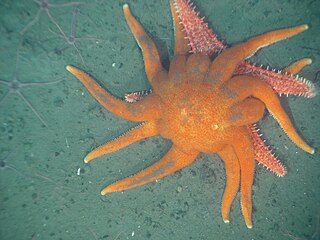
The Valvatida are an order of starfish in the class Asteroidea, which contains 695 species in 172 genera in 17 families.
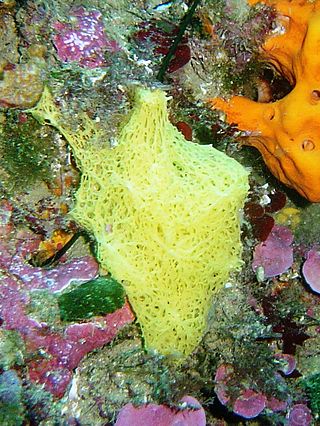
Clathrinidae is a family of calcareous sponges in the order Clathrinida. It contains the following genera:

Zoanthids are an order of cnidarians commonly found in coral reefs, the deep sea and many other marine environments around the world. These animals come in a variety of different colonizing formations and in numerous different colors. They can be found as individual polyps, attached by a fleshy stolon or a mat that can be created from small pieces of sediment, sand and rock. The term "zoanthid" refers to all animals within this order Zoantharia, and should not be confused with "Zoanthus", which is one genus within Zoantharia.
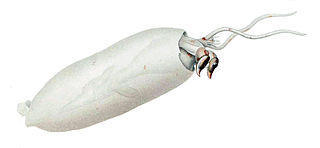
Taoniinae is a subfamily containing ten genera of glass squids.
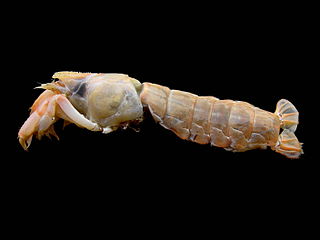
Upogebiidae is a family of mud shrimp crustaceans belonging to the infraorder Gebiidea, within the order Decapoda. They are infauna, living their entire adult lives in seafloor burrows. Over 100 species have been identified, with different species often highly specialized for different types of substrate, even including sea sponges or coral. They are filter feeders, although some species also deposit feed.

Rhina ancylostoma, the bowmouth guitarfish, shark ray or mud skate, is a species of ray and a member of the family Rhinidae. Its evolutionary affinities are not fully resolved, though it may be related to true guitarfishes and skates. This rare species occurs widely in the tropical coastal waters of the western Indo-Pacific, at depths of up to 90 m (300 ft). Highly distinctive in appearance, Rhina ancylostoma has a wide and thick body with a rounded snout and large shark-like dorsal and tail fins. Its mouth forms a W-shaped undulating line, and there are multiple thorny ridges over its head and back. It has a dorsal color pattern of many white spots over a bluish gray to brown background, with a pair of prominent black markings over the pectoral fins. This large species can reach a length of 2.7 m (8.9 ft) and weight of 135 kg (298 lb).

The pale-edged stingray or sharpnose stingray is a species of stingray in the family Dasyatidae, found in the Indian and Pacific Oceans from India to the western Malay Archipelago and southern Japan. This bottom-dwelling ray is most commonly found over sandy areas shallower than 100 m (330 ft), as well as in estuaries. Measuring up to 29 cm (11 in) across, the pale-edged stingray has a diamond-shaped pectoral fin disc, a long projecting snout, small eyes, and a whip-like tail with both dorsal and ventral fin folds. It is chocolate brown above and white below.

Carditidae is a family of marine bivalve clams of the order Carditida, which was long included in the Venerida. They are the type taxon of the superfamily Carditoidea.

Lottiidae is a family of sea snails, specifically true limpets, marine gastropod mollusks in the superfamily Lottioidea and the clade Patellogastropoda.

Sapphirinidae is a family of parasitic copepods in the order Cyclopoida.
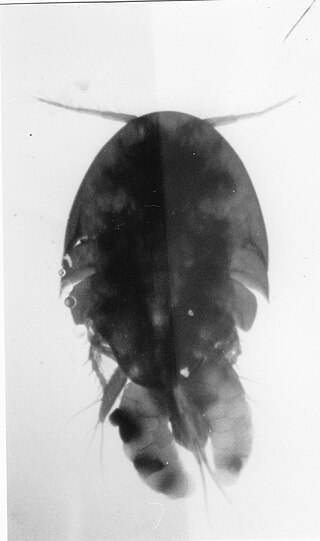
Clausidiidae is a family of parasitic copepods in the order Cyclopoida, containing the following genera:

Xeniidae is a family of soft coral in the order Alcyonacea.
Taiaroa is a genus of deep-water, solitary marine octocorals in the family Taiaroidae. Taiaroa is monotypic in the family Taiaroidae and contains a single species, Taiaroa tauhou. The species was first described by the marine zoologists Frederick M. Bayer and Katherine Margaret Muzik in 1976. The scientific name derives from "Taiaroa", the submarine canyon off New Zealand in which the first specimens were found and "tauhou", the Maori word for "strange".

Rhinopristiformes is an order of rays, cartilaginous fishes related to sharks, containing shovelnose rays and allied groups.

Heteropsammia is a genus of apozooxanthellate corals that belong to the family Dendrophylliidae.

Aeropsidae is a family of echinoderms belonging to the order Spatangoida. It contains one extant genus. There are also eight extinct genera, most of which fall in the subfamily Corasterinae.

Laomediidae is a family of mud shrimp crustaceans belonging to the infraorder Gebiidea, within the order Decapoda.

Dallinidae(Dallinidae Beecher) is a family of loopbearing brachiopods belonging to the order Terebratulida.
Axianassidae is a family of mud shrimp crustaceans belonging to the infraorder Gebiidea, within the order Decapoda.

















